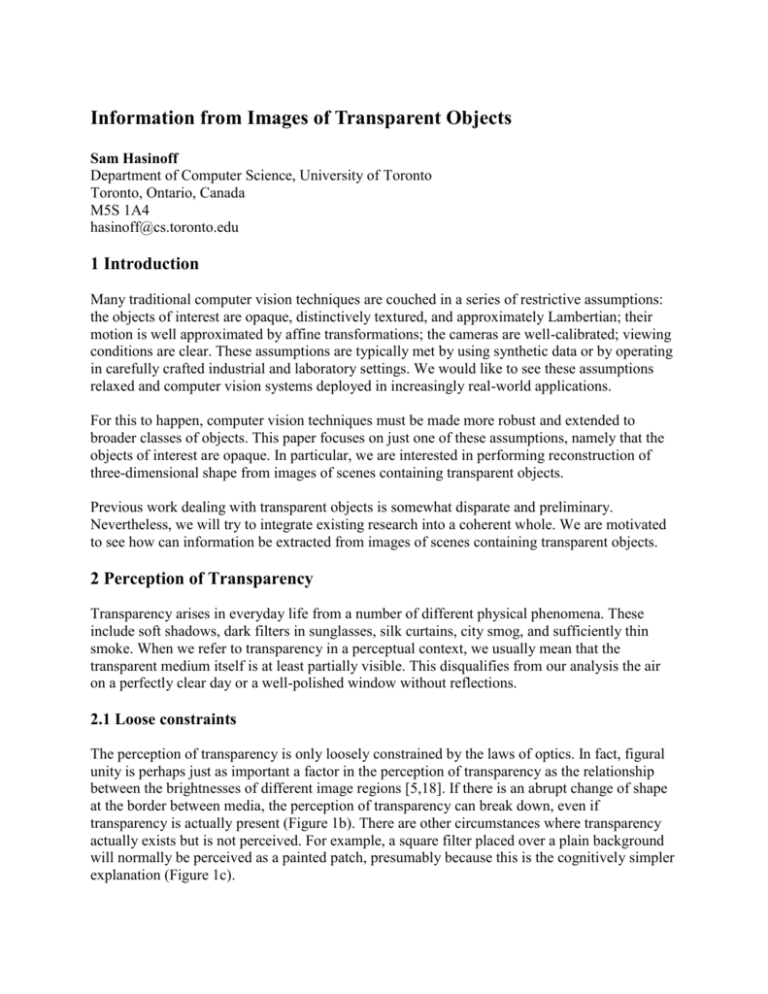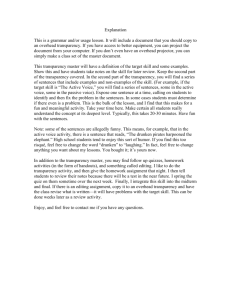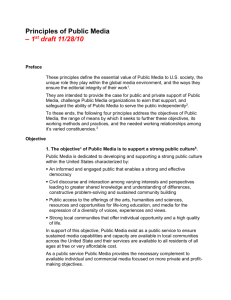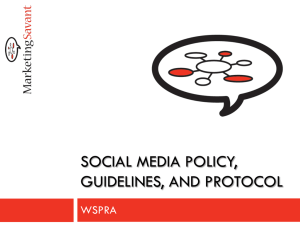Information from Images of Transparent Objects
advertisement

Information from Images of Transparent Objects Sam Hasinoff Department of Computer Science, University of Toronto Toronto, Ontario, Canada M5S 1A4 hasinoff@cs.toronto.edu 1 Introduction Many traditional computer vision techniques are couched in a series of restrictive assumptions: the objects of interest are opaque, distinctively textured, and approximately Lambertian; their motion is well approximated by affine transformations; the cameras are well-calibrated; viewing conditions are clear. These assumptions are typically met by using synthetic data or by operating in carefully crafted industrial and laboratory settings. We would like to see these assumptions relaxed and computer vision systems deployed in increasingly real-world applications. For this to happen, computer vision techniques must be made more robust and extended to broader classes of objects. This paper focuses on just one of these assumptions, namely that the objects of interest are opaque. In particular, we are interested in performing reconstruction of three-dimensional shape from images of scenes containing transparent objects. Previous work dealing with transparent objects is somewhat disparate and preliminary. Nevertheless, we will try to integrate existing research into a coherent whole. We are motivated to see how can information be extracted from images of scenes containing transparent objects. 2 Perception of Transparency Transparency arises in everyday life from a number of different physical phenomena. These include soft shadows, dark filters in sunglasses, silk curtains, city smog, and sufficiently thin smoke. When we refer to transparency in a perceptual context, we usually mean that the transparent medium itself is at least partially visible. This disqualifies from our analysis the air on a perfectly clear day or a well-polished window without reflections. 2.1 Loose constraints The perception of transparency is only loosely constrained by the laws of optics. In fact, figural unity is perhaps just as important a factor in the perception of transparency as the relationship between the brightnesses of different image regions [5,18]. If there is an abrupt change of shape at the border between media, the perception of transparency can break down, even if transparency is actually present (Figure 1b). There are other circumstances where transparency actually exists but is not perceived. For example, a square filter placed over a plain background will normally be perceived as a painted patch, presumably because this is the cognitively simpler explanation (Figure 1c). Figure 1. The regular perception of transparency is illustrated in (a). Most subjects will report seeing a small transparent square above a large dark square. However, the perception of transparency can be disrupted, as shown in (b), by a sudden change of shape. Transparency will not be perceived in (c) either. Even if the smaller square is in fact transparent, the scene can be explained more simply without transparency. Nakayama also demonstrated experimentally that transparency is fundamentally achromatic in nature [21]. Combinations of colour which are unlikely to arise in real-world scenes still give the perception of transparency. Previous theories of visual perception have described cognitive models in which more complicated images can be described economically using primitive images and combination rules. In particular, Adelson and Pentland formulated an explicit cost model for performing such a decomposition, as a concrete illustration of this idea [1]. Using this formulation, the most plausible interpretations of a scene are the cheapest interpretations (in terms of shape, lighting, and reflectance) that are consistent with the image. It seems at first glance that transparency would fit nicely into this cost-based framework, however Adelson and Anandan argue that this is not in fact the case [2]. According to them, transparency is essentially pre-physical and heuristic in nature, and not part of a full intrinsic image analysis. 2.2 The importance of X-junctions Metelli was the first to analyze constraints on the perception of transparency with layers of transparent two-dimensional shapes [20]. In his model, each layer can attenuate the luminance beneath it by a factor a, 0 < a 1, and emit its own luminance e, e 0. Thus, the luminance at layer n is given by the relation In = anIn-1 + en. The constraints imposed by this model have been recently examined at so-called X-junctions, which are places in an image where four different regions are created from the intersection of two lines. X-junctions have been shown to be especially important in establishing local constraints for scene interpretation. These local constraints propagate quickly to constrain the interpretation of the entire scene. It has been proposed that the human visual system employs heuristics based on X-junctions to categorize different types of transparency [2]. X-junctions can be classified into three groups based on the ordinal relationship between the brightnesses of the regions in the horizontal and vertical directions. The non-reversing (Figure 2a) and single-reversing (Figure 2b) cases are both readily perceived as transparent, but in the non-reversing case the depth ordering is ambiguous. On the other hand, the double-reversing case (Figure 2c) is not perceived as transparent. Satisfyingly enough, a mathematical analysis of Metelli’s rule at X-junctions leads to constraints which justify heuristics based on the degree of reversingness. Figure 2. We classify X-junctions into three different groups based on whether sign is preserved in the horizontal and vertical directions. Transparency is perceived in both the non-reversing (a) and singlereversing (b) case, but the non-reversing case has two plausible interpretations for the depth ordering. The double-reversing case (c) is not perceived as transparent. Note that transparency has also been shown to be eagerly perceived by (untrained) observers, even in a number of physically impossible situations, as when the ordinal relationships required at X-junctions are violated [5]. However, this effect may be partially due to demand characteristics in the experimental design. 2.3 The perception of transparency in 3D It has been demonstrated experimentally to be difficult to make judgments about 3D transparent shapes. One technique suggested for improving the visualization of 3D transparent shapes involves overlaying strokes at points on the surface of the shape, where the orientation and size of the strokes are chosen to correspond to the direction and magnitude of principal curvature [18]. This texturing is shown to improve performance in judging relative distances for a medical visualization task. Interestingly, these results also suggest that reconstruction of a transparent 3D shape might not have to be as accurate as that of a textured opaque object, so long as its contour and other salient features are preserved. 3 Computerized Tomography A large field of research involving the imaging of transparent objects is computerized tomography (CT), which can be defined as the reconstruction of sectional slices of an object from image measurements taken from different orientations [17]. The applications of CT are farreaching and diverse, including medical imaging, airport security, and non-destructive testing in manufacturing. In standard computer vision, we only consider images formed using visible light, and most models of transparency assume a discrete number of object layers with associated uniform transparencies. The volumetric models which incorporate transparency are an uncommon and notable exception. CT systems, by contrast, involve images taken using high frequency electromagnetic radiation capable of penetrating objects opaque to the naked eye. In this way, CT image intensities (suitably transformed to account for attenuation) can be interpreted as proportional to masses along the imaging rays between the source of the radiation and the detector. The tomographic imaging process can be described mathematically by a parallel projection known as the Radon transform (Figure 3). The mass density f(x, y) over a 2D slice of the object is projected in many different viewing directions, , giving rise to 1D images parameterized by d, as follows: P( , d ) f ( x, y ) ( x cos y sin d )dxdy, where (t) is the Dirac delta function. Figure 3. The geometry of the Radon transform. To give a concrete example, X-ray CT has found wide use in medical applications due to its penetrating power through human tissue and its high contrast. Using tomographic techniques, the internal structure of the human body can be reliably imaged in three dimensions for diagnostic purposes. There are, however, a few limitations to the technique. Good reconstructions require a great deal of data (meaning many rays from many directions), so a large detector typically need be spun completely about the patient for full coverage. Quite aside from concerns of efficiency, human exposure to X-rays should be limited for health reasons. Moreover, because the reconstruction is typically very sensitive to noise, the patient is instructed to remain immobile throughout the procedure. This may be especially difficult for those injured patients for whom the CT scan is most valuable. Finally, any objects embedded in the body that are opaque to X-rays (for example, lead shrapnel) can cause significant shadowing artefacts in the reconstruction. 3.1 Filtered backprojection The Fourier slice theorem gives a simple relationship (in the Fourier domain) between the object and its projections. Specifically, the Fourier transform of a 1D projection can be shown to be equivalent to a slice of the 2D Fourier transform of the original object in a direction perpendicular to the direction of projection [17]. In the case of continuous images and unlimited views, the Fourier slice theorem can be applied directly to obtain a perfect reconstruction. Each projection can be backprojected onto the 2D Fourier domain by means of the Fourier slice theorem, and the original object can then be recovered by simply taking the inverse 2D Fourier transform. In real applications, the results are less ideal. This is because only a discrete number of samples are ever available but also because backprojection tends to be very sensitive to noise. The sensitivity to noise is due to the fact that the Radon transform is a smoothing transformation, so taking its inverse will have the effect of amplifying noise. To partially remedy this problem, the CT images are usually filtered (basically using a high-pass filter) before undertaking backprojection. These two steps, filtering and backprojection, are the essence of the filtered backprojection (FBP) algorithm which has dominated CT reconstruction algorithms for the past thirty years. In practice, FBP produces very high quality results, but many views (hundreds) are required and the method is still rather sensitive to noise. FBP has even been extended in an ad hoc way to visible light images of (opaque) objects [12]. This technique mistreats occlusion, but for mostly convex Lambertian surfaces, it provides a simple method for obtaining high-resolution 3D reconstructions. Wavelets have also been used to extend FBP for CT reconstruction. The idea is to apply the wavelet transform at the level of the 1D projections, which in turn induces a multiscale decomposition of the 2D object. For a fixed level of detail, this method is equivalent to FBP, but has the advantage of obtaining multiresolution information with little additional cost. More importantly, the wavelet method also provides a better framework for coping with noise. Bhatia and Karl suggest an efficient approach to estimating the maximum a posteriori (MAP) reconstruction using wavelets, in contrast to other more computationally intensive regularization approaches of doing this [6]. 3.2 Algebraic methods An alternative method for CT involves reformulating the problem in an algebraic framework. If we consider the object as being composed of a grid of unknown mass densities, then each ray in for which we record an image intensity will impose a different algebraic constraint. Reconstruction is then reduced to the conceptually simple task of finding the object which best fits the projection data. This best fit will typically be found through some kind of iterative optimization technique, perhaps with additional regularization constraints to reduce non- smoothness artefacts. While algebraic methods are slow and lack the accuracy of FBP, they are the only viable alternative for handling very noisy or sparse data. Algebraic methods have also been proposed for handling cases like curved rays which are difficult to model using insights from Fourier theory. The first method developed using the algebraic framework was the algebraic reconstruction technique (ART) [17]. Starting from some initial guess, this method applies each of the individual constraints in turn. The difference between the measured and the computed sum along a given ray is then used to update the solution by a straightforward reprojection. Unfortunately, the results obtained using basic ART are rather poor. The reconstruction is plagued with salt-and-pepper noise and the convergence is unacceptably slow. Results can be improved somewhat by introducing weighting coefficients to do bilinear interpolation of the mass density pixels, and adding a relaxation parameter (as in simulated annealing) at the further expense of convergence. Improvements have also been demonstrated by ordering the constraints so that the angle between successive rays is large, and by modifying the correction terms using some heuristic to emphasize the central portions of the object (for example, adding a longitudinal Hamming window). Mild variations on ART, including the simultaneous iterative reconstruction technique (SIRT) and the simultaneous algebraic reconstruction technique (SART), differ only in how corrections from the various constraints are bundled and applied [3,16]. In SIRT, all constraints are considered before the solution is updated with the average of their corrections. SART can be understood as a middle ground between ART and SIRT. It involves applying a bundle of constraints from one view at a time. 3.3 Statistical methods Another group of iterative techniques built around the same algebraic framework are more statistical in nature. The expectation maximization (EM) algorithm is one example of such a technique. Statistical methods seek explicitly to maximize the maximum likelihood (ML) reconstruction which most closely matches the data, however properties expected in the original object, such as smoothness, may be lost. Bayesian methods have also been proposed, in which prior knowledge can be incorporated into the reconstruction [13]. To improve the quality of reconstruction, penalty functions are often introduced to discourage local irregularity. This regularization, however, comes at the cost of losing resolution in the final image. The overall cost function is typically designed to be quadratic, to permit the application of gradient methods. Gradient ascent and conjugate gradient methods have been suggested, as well as other finite grid methods similar to Gauss-Seidel iteration [24]. 4 Volumetric Reconstruction with Transparency The voxel colouring algorithm of Seitz and Dyer was the first method for performing volumetric reconstruction from images (of opaque objects) that properly accounted for visibility [25]. Kutulakos and Seitz later extended this method to obtain the space carving algorithm [19]. Both algorithms operate on the principle that cameras must agree on the colour of an (opaque) voxel, though only if that voxel is visible from all of those cameras. In this framework, voxels are labelled as either completely transparent or completely opaque. Note that even for opaque objects, a perfect voxel reconstruction would require transparency (partial occupancy) information to be computed for the voxels at the boundaries of the objects. Several recent volumetric reconstruction techniques have attempted explicitly to recover transparencies along with voxel colouring information. In this model, observed pixel intensity is a weighted combination of voxel colours along the ray, where the weights are a function of the voxel transparencies. None of these methods, however, attempt to recover the scene illumination or estimate surface reflectance. As a result, complicated lighting phenomena such as specular highlights and inter-reflections are ignored completely. In other words, the reconstructed shape is in some sense derived from shading. 4.1 Volumetric backprojection Dachille et al. report one such reconstruction method they call volumetric backprojection [9]. The method is a straightforward extension of SART, made efficient with hardware acceleration and a parallel architecture for performing backprojection on a slice-by-slice basis. If each image is available with both black and white backgrounds, a simple matting technique (see Section 6.1) can be applied to extract the cumulative effect of transparency on each pixel. Then, correction terms for both voxel colours as well as voxel transparencies can be backprojected onto the reconstruction volume. Results are demonstrated successfully for synthetic data, where the exact lighting conditions are made available to the reconstruction algorithm. While this represents an interesting proof of concept, it is unclear that this technique would work well on real reconstruction tasks, where noise and unknown lighting conditions may be serious issues. 4.2 Roxel algorithm Another volumetric reconstruction technique incorporating transparency is the Roxel algorithm proposed by De Bonet and Viola [10]. In this approach, responsibilities (weights) are assigned along rays to describe the relative effects of the voxels in determining observed pixel colour. Responsibilities are thus due to the cumulative effect of transparency in attenuating the colours of the voxels. While the relationship between responsibilities and transparencies is non-linear, a closed form is available for converting directly between the two representations. Initially the entire volume is set to be empty and completely transparent. Each iteration of the method comprises the following sequence of three steps. First, colours are estimated using a generalization of backprojection, in which voxel colours are weighted by their responsibilities. Then, responsibilities are estimated based on the disagreement between the estimated pixel colour and the real image data. To distribute responsibility among the voxels in each ray, a softmax style assignment (as in reinforcement learning) is made. Voxels that agree better with the data are given a greater share of the responsibility, and the overall distribution is controlled by a single parameter expressing belief in the noisiness of the data. Finally, both the responsibilities and the related transparencies are renormalized to be globally consistent over the entire set of view estimates. Results are demonstrated for a variety of synthetic and real data, and the reconstructions are of fairly good quality, especially for opaque objects. Another interesting aspect of the Roxel algorithm is that uncertainty in the reconstruction is also represented by transparency. Thus, an opaque but uncertain voxel will be rendered as semi-transparent, corresponding to its expected value. One serious criticism of the Roxel algorithm is that the method is too heuristic. Its image formation model for opaque surfaces has also been criticized, because visibility is assessed only by assuming that the voxels in front are transparent [7]. This could lead to unusual artefacts for more complicated geometries. Furthermore, no proof of convergence is given, although in practice the convergence behaviour does seem stable. 5 Mixed Pixels Some standard vision algorithms, such as estimating depth from stereo or computing optical flow, have recently been extended to handle transparency to some degree. However, most of these extensions were not motivated by the desire to better handle general transparent objects. Rather, their typical goal was to improve behaviour at troublesome mixed pixels, which are pixels whose colour is due to a combination of different objects. Mixed pixels arise at object boundaries, where object detail is small relative to pixel size, and of course, wherever transparency is a factor. Properly coping with mixed pixels involves managing multiple explanations per pixel, so these algorithms tend to be more complicated than their predecessors. Although these methods may advertise themselves as supporting transparency, the degree of transparency modeled is usually rather limited, and their performance with more general transparent objects poor. 5.1 Stereo algorithms Szeliski and Golland present a stereo algorithm within operates over discretized scene space, but also adds an explicit representation for partially transparent regions [27]. Like other volumetric stereo methods, evidence for competing correspondences is considered. This method differs in allowing the detection of mixed pixels at occlusion boundaries in order to obtain sub-pixel accuracy. Estimates for colour and transparency are refined using a global optimization method which penalizes non-smoothness and encourages transparencies to be either 0 or 1. Another stereo algorithm which accounts for transparency was proposed by Baker, Szeliski, and Anandan [4]. Their method models the scene as a collection of approximately planar layers, or sprites. These sprites are initially estimated without considering transparency, then this solution is refined iteratively. First, residual depths perpendicular to the planes are estimated, then perpixel transparencies are estimated as well. The images are re-synthesized using a generative model that incorporates transparency, and error with respect to the input images is minimized using gradient descent. Both methods achieve impressive gains over previous results, and this improvement may be directly attributed to better handling of mixed pixels. However, in neither case are results presented for scenes containing real transparent objects. 5.2 Motion analysis Irani, Rousso, and Peleg present a high-level motion analysis technique, geared at extracting a small number of dominant motions, where the objects may be occluded or transparent [15]. The technique proceeds recursively. First, the dominant affine motion is estimated using temporal integration. This produces an integrated image that is sharp for pixels involved in the dominant motion and blurred for the others. The sharp pixels are then segmented and removed from the original sequence, so that the algorithm can estimate the next most dominant motion. The integration process is robust to occlusion, and the algorithm even handles certain types of transparent motions. The success of the algorithm in the presence of transparency depends on different levels of contrast to allow the identification one dominant transparent motion. It also depends on the assumption that the dominant transparent motion can be approximately removed from the sequence by simply considering the difference between the original frames and the integrated image. Good results are presented for a picture frame partially reflecting objects behind the camera. The skin and bones method suggested by Ju, Black, and Jepson also handles transparency in its estimation of optical flow [16]. Robust statistical techniques and mixture models are used to estimate multiple layers of motion within fixed patches of the scene, and regularization constraints ensure that smoothness between nearby and related patches is maintained. Transparency is handled in that multiple depth measurements are allowed to exist for each pixel, and the regularization step will automatically segment the data into different surfaces. The skin and bones method can be viewed as a hybrid between dense optical flow methods and global parametric models which extract only the dominant motions. 5.3 Volumetric reconstruction Accounting for mixed pixels is also important when performing volumetric reconstruction from images. The space carving technique, as previously described, assesses visibility by determining whether a given voxel projects to roughly the same colour in a set of images [19]. However, if a given voxel is located at a depth discontinuity with different backgrounds from different views, then the resulting (mixed) pixel projections may appear inconsistent and lead the algorithm to label the voxel (incorrectly) as empty. The approximate space carving method [18] attempted to remedy this problem (and other sources of noise) by broadening the notion of colour consistency between image pixels. Kutulakos describes the shuffle transform, a looser matching criterion where arbitrary reordering of pixels within a local neighbourhood is permitted. Other approximate matching criteria such those based on rank order within a local neighbourhood can also improve performance in this situation. Space carving has lately been extended using probabilistic methods to permit the representation of partial or expected voxel occupancy [7]. The basic space carving algorithm was modified to incorporate stochastic sampling, and the algorithm is shown to generate fair samples from a distribution which accurately models the probabilistic dependencies between voxel visibilities. This approach provides a principled manner of dealing with uncertainty in the reconstruction and handles mixed pixels with good results. 6 Matting Techniques Matting is another important application for transparency. The process of matting involves separating foreground objects from the background, typically so that they can then be composited over a new background. In matting, transparency is modeled on a per-pixel basis, rather than in scene space. This model nevertheless allows good results to be obtained at mixed boundary pixels and permits the foreground objects themselves to be transparent. The end result of the matting process is an image (a matte) that is transparent in regions of the foreground object, opaque in the background regions, and semi-transparent at object boundaries and wherever the foreground object is semi-transparent. This is completely analogous to the alpha channel used in computer graphics. 6.1 Blue screen matting and extensions Historically, the driving force behind matting technology has been the film industry, which employs these techniques to produce special effects. Vlahos pioneered the well-known blue screen matting technique over forty years ago, and refinements of this technique are still in use today. The basic idea is to film the foreground object (usually an actor) in front of a bright screen of known colour (usually blue). If the object is relatively unsaturated, perhaps near-grey or flesh coloured, a simple equation involving the background and observed foreground colours allows the transparency to be calculated at every pixel [26]. Human intervention is usually needed to identify a good matte when using commercial matting machines. Smith and Blinn demonstrate mathematically that the general matting problem is unsolvable, but justify traditional approaches to matting by showing how certain constraints reduce the space of solutions [26]. They also suggest a novel approach to matting that they call triangulation. This method requires the object to be filmed against two or more backgrounds which must differ at every pixel. The solution to the matting problem then becomes overdetermined, so that fitting can be performed in the least-squares sense. The main difficulty with the method is its lack of applicability when either the object or the camera is moving. If the object is static and the camera is computercontrolled, then in theory, two separate passes can be made, however maintaining proper calibration remains a issue. 6.2 Environment matting The environment matting framework proposed by Zongker et al. extends these ideas even further in order to capture the refractive and reflective properties of foreground objects [28]. The extraordinary results obtained using this method (for static objects) are practically indistinguishable from real photographs. While additional research has been done in capturing environment mattes from moving objects in front of a single known background, the simplifying assumptions required to make this possible cause the accuracy to suffer significantly [8]. The basic environment matting method operates by photographing the foreground object with a series of structured images behind it and to the sides of it. Then, for each pixel, a non-linear optimization problem is solved, which attempts to find the coverage of the foreground object and the axis-aligned rectangle in the background which best reproduces the pixel colour over all of the input images. The backgrounds are chosen to be a hierarchical set of horizontal and vertical striped patterns, corresponding to one-dimensional Gray codes. This simplifies the calculation of average value within axis-aligned rectangles in the background, and reduces the dimensionality of the optimization to a more manageable three. In further work, additional accuracy was obtained by using swept Gaussian stripes as background images [8]. By considering stripes with different orientations, the environment matte could be recovered as a set of oriented elliptical Gaussians instead of axis-aligned rectangles. This allows much greater realism for objects made from anisotropic materials, such as brushed steel. 7 Vision in Bad Weather In computer graphics, sophisticated physically-based models have been suggested to animate and render atmospheric phenomena such as clouds, fog, and smoke. One proposed method for visualizing smoke was based on radiosity style techniques to approximate the effects of multiple scattering [11]. Computer vision techniques, on the other hand, often assume that viewing conditions are clear and are rarely explicit in considering the effects of atmospheric phenomena on image formation. Nayar and Narasimhan have proposed that the effects of bad weather should be considered when designing vision systems [23,22]. Moreover, they describe how bad weather conditions might even be turned to an advantage, if we take the view that the atmosphere acts to modulate information about the scene. They describe algorithms that estimate additional information about the scene such as relative depth, given an atmospheric model. This extraction of additional information is made possible by making simplifying assumptions about the atmospheric model. Namely, these techniques work best under uniformly hazy conditions, and do not cope well with more sophisticated scattering phenomena. For example, the situation where the sun selectively breaks through certain areas of low-lying clouds would be modeled quite poorly. 7.1 Depths from attenuation Using multiple images of the same scene taken under different weather conditions, relative depths of point light sources can be estimated by comparing the degree of attenuation in the images [23]. If the images are taken at night, illumination from the environment is negligible and a simple scattering model suffices. The optical thicknesses of the different weather conditions can then be easily computed in order to estimate the relative depths. 7.2 Depths from airlight Another technique involves estimating relative depths from a single image of a scene that is blanketed in dense grey haze [23]. In this situation (all too common in many urban areas), the dominant source of image irradiance is a phenomenon known as airlight. Airlight causes the hazy atmosphere to behave as a source of light, through the scattering effect of its constituent particles, so that brightness will increase as a function of path length. By measuring the image intensity at the horizon, which will correspond to an infinite path length, the airlight formula can be used to extract relative depths from different image intensities. 7.3 Dichromatic model of bad weather Narasimhan and Nayar also derived a dichromatic model for atmospheric scattering, showing that the colour of a point under bad weather conditions is a linear combination of its clearweather colour and its airlight colour [22]. The direction of the airlight colour is constant over the entire scene, so this direction can be computed robustly by intersecting the dichromatic planes corresponding to the different colours which appear in the image. This also allows the relative magnitudes of airlight colours to be determined for all the points in the scene. Then, given multiple images of the scene taken under different weather conditions, relative depths can be estimated even more reliably by using only the airlight components of the image colours. Moreover, true colours can also be determined for the entire scene given the clearweather colour of just a single point in the image. 8 Discussion Transparency complicates things. Algorithms that work reliably on opaque objects fail embarrassingly in the presence of transparency. The algorithms that do attempt to handle transparency often make serious compromises, accepting simplified models of transparency but still suffering from added complexity. What worsens things from an analytical point of view is that the amorphous concept labelled transparency is often really multiple concepts rolled together. Transparency has variously been used to represent partial coverage of a pixel by a foreground object, the degree to which light from the background can pass through an object, uncertainty about the contents of a pixel, and different combinations of these. Much of the research described could have benefited from more clarity in defining precisely which of these features were intended to be modeled. The perception of transparency is by all accounts heuristic and not very well constrained. This has the implication that three-dimensional reconstructions of transparent objects might not need to be so accurate in order to convince a casual observer. It also suggests additional experiments for determining the nature of these heuristics. One might investigate the process by which the rules governing the perception of transparency are learned by studying its early development in animals and the young. While transparency is a fertile area for research in computer vision, the accurate modeling of transparency is by no means an end goal. Research on transparency is being broadened to even richer models of light transport, including such phenomena as refraction, reflection, and scattering. The environment matting technique and various work on vision in bad weather are early examples of this trend. The modeling and recovery of physical scene attributes continues to improve, and so the gap between the representations used in computer vision and computer graphics will continue to narrow over the next decade. References [1] E. Adelson and A. Pentland. The perception of shading and reflectance. In D. Knill and W. Richards (eds.), Perception as Bayesian Inference. Cambridge University Press, New York, pp. 409-423, 1996. [2] E. Adelson and P. Anandan. Ordinal characteristics of transparency. In AAAI-90 Workshop on Qualitative Vision, pp. 77-81, 1990. [3] A. Andersen and A. Kak. Simultaneous Algebraic Reconstruction Technique (SART): A superior implementation of the ART algorithm. Ultrasonic Imaging, 6:81-94, 1984. [4] S. Baker, R. Szeliski, and P. Anandan. A layered approach to stereo reconstruction. In IEEE Computer Vision and Pattern Recognition, pp. 434-441, 1998. [5] J. Beck and R. Ivry, On the role of figural organization in perceptual transparency. Perception and Psychophysics, 44 (6), pp. 585-594, 1988. [6] M. Bhatia, W. Karl, and A. Willsky. A wavelet-based method for multiscale tomographic reconstruction. IEEE Trans. On Medical Imaging, 15(1), pp. 92-101, 1996. [7] R. Bhotika, D. Fleet, and K. Kutulakos. A probabilistic theory of occupancy and emptiness. In submission, 2001. [8] Y. Chuang, et al. Environment matting extensions: Towards higher accuracy and real-time capture. In Proc. ACM SIGGRAPH, pp. 121-130, 2000. [9] F. Dachille, K. Mueller, and A. Kaufman. Volumetric backprojection. In Proc. Volume Visualization and Graphics Symposium, pages 109-117, 2000. [10] J. DeBonet and P. Viola. Roxels: Responsibility weighted 3D volume reconstruction. In Proc. Int. Conf. on Computer Vision, pp. 418-425, 1999. [11] R. Fedkiw, J. Stam, and H. Jensen. Visual simulation of smoke. In Proc. ACM SIGGRAPH, pp. 23-30, 2001. [12] D. Gering and W. Wells III. Object modeling using tomography and photography. In Proc. IEEE Workshop on Multi-View Modeling and Analysis of Visual Scenes, pp. 11-18, 1999. [13] K. Hanson and G. Wecksung. Bayesian approach to limited-angle reconstruction in computed tomography. Journal of the Optical Society of America, 73(11), pp. 1501-1509, 1983. [14] V. Interrante, H. Fuchs, and S. Pizer. Conveying the 3D shape of smoothly curving transparent surfaces via texture. IEEE Trans. On Visualization and Computer Graphics, 3(2), pp. 98-117, 1997. [15] M. Irani, B. Rousso, and S. Peleg. Computing occluding and transparent motions. International Journal of Computer Vision, 12(1), pp. 5-15, 1994. [16] S. Ju, M. Black, and A. Jepson. Skin and bones: Multi-layer, locally affine, optical flow and regularization with transparency. In Proc. IEEE Conf. on Computer Vision and Pattern Recognition, pp. 307-314, 1996. [17] A. Kak and M. Slaney. Principles of Computerized Tomographic Imaging. IEEE Press, New York, 1987. [18] K. Kutulakos, Approximate N-View Stereo, In Proc. European Conference on Computer Vision, pp. 67-83, 2000. [19] K. Kutulakos and S. Seitz. A theory of shape by shape carving. International Journal of Computer Vision, 38(3), pp. 197-216, 2000. [20] F. Metelli. The perception of transparency. Scientific American, 230 (4), pp. 90-98. 1974. [21] K. Nakayama, S. Shimojo, and V. Ramachandran. Transparency: relation to depth, subjective contours, luminance, and neon color spreading. Perception, 19, pp. 497-513, 1990. [22] S. Narasimhan and S. Nayar, Chromatic framework for vision in bad weather. In Proc. IEEE Conf. on Computer Vision and Pattern Recognition, pp. 598-605, 2000. [23] S. Nayar and S. Narasimhan, Vision in bad weather. In Proc. Int. Conf. on Computer Vision, pp. 820-827, 1999. [24] K. Sauer and C. Bouman. A local update strategy for iterative reconstruction from projections. IEEE Trans. On Signal Processing, 41(2), pp. 5234-548, 1993. [25] Seitz, S. and C. Dyer. Photorealistic scene reconstruction by voxel coloring. International Journal of Computer Vision, 35(2), pp. 151-173, 1999. [26] A. Smith and J. Blinn, Blue screen matting. In Proc. ACM SIGGRAPH, pp. 259-268, 1996. [27] R. Szeliski and P. Golland, Stereo matching with transparency and matting. In Proc. Int. Conf. on Computer Vision, pp. 517-524, 1998. [28] D. Zongker, D. Werner, B. Curless, D. Salesin. Environment matting and compositing. In Proc. ACM SIGGRAPH, pp. 205-214, 1999.








